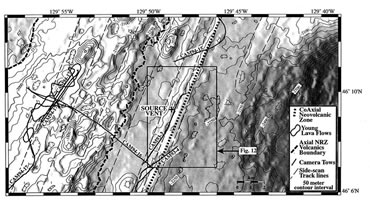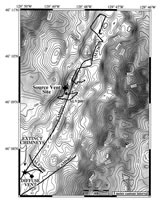U.S. Dept. of Commerce / NOAA / OAR / PMEL
/ Publications
Recent eruptions on the CoAxial segment of the Juan de Fuca Ridge:
Implications for mid-ocean ridge accretion processes
R. W. Embley,1 W. W. Chadwick,2 M. R. Perfit,3
M. C. Smith,3 and J. R. Delaney4
1Pacific Marine Environmental Laboratory, National Oceanic
and Atmospheric Administration, Hatfield Marine Science Center, Newport, Oregon
97365
2Cooperative Institute for Marine Resources Studies, Oregon State
University, Hatfield Marine Science Center, Newport, Oregon 97365
3Department of Geology, University of Florida, Gainesville, Florida,
32611
4School of Oceanography, University of Washington, Seattle, WA 98195
Journal of Geophysical Research, 105(B7),
16,501–16,525 (2000).
Copyright ©2000 by the American Geophysical Union. Further electronic distribution
is not allowed.
9. Southern CoAxial Segment and the "Source Site"
The southern third of the CoAxial axial valley (south of about 46°14 N)
is characterized by a distinct median volcanic ridge (Plate
1 and Figure 11). The ridge summit is covered
with young pillow lavas with small pockets of sediment and small areas of sheet
flows at its southern end (~46°07
N)
is characterized by a distinct median volcanic ridge (Plate
1 and Figure 11). The ridge summit is covered
with young pillow lavas with small pockets of sediment and small areas of sheet
flows at its southern end (~46°07 N)
where it broadens. Seafloor between the median ridge and the AVNRZ (dashed line
on Figure 11) consists of heavily sedimented
sheet flows (Plate 3g). A young pillow mound
on the axis of the AVNRZ centered at 46°10
N)
where it broadens. Seafloor between the median ridge and the AVNRZ (dashed line
on Figure 11) consists of heavily sedimented
sheet flows (Plate 3g). A young pillow mound
on the axis of the AVNRZ centered at 46°10 N,
129°55
N,
129°55 W (Figure
11) mapped by the towed camera probably represents a single eruption from
a recent diking episode originating at or near the summit of Axial Volcano.
No SeaBeam anomaly was found at this site, so it apparently precedes all of
the historic CoAxial eruptions.
W (Figure
11) mapped by the towed camera probably represents a single eruption from
a recent diking episode originating at or near the summit of Axial Volcano.
No SeaBeam anomaly was found at this site, so it apparently precedes all of
the historic CoAxial eruptions.

Figure 11. Bathymetric map of southern CoAxial segment including the Source
site. See Figure 5 caption for details. Location
of Figure 12 is shown by box.
CTDT tows along this part of the CoAxial segment in October 1993 encountered
a hydrothermal plume centered around 46°09 N
(Figure 11) that was clearly separate from the
plumes originating at the known Floc and Flow sites to the north [Baker
et al., 1998] . The high-temperature vent site subsequently discovered
on Alvin dive 2681 in October 1993 became known as the "Source site"
because it was postulated that this site may have represented the magma source
region that generated the 1993 dike injection [Butterfield
et al., 1997].
N
(Figure 11) that was clearly separate from the
plumes originating at the known Floc and Flow sites to the north [Baker
et al., 1998] . The high-temperature vent site subsequently discovered
on Alvin dive 2681 in October 1993 became known as the "Source site"
because it was postulated that this site may have represented the magma source
region that generated the 1993 dike injection [Butterfield
et al., 1997].
The Source vent field is located on the west side of the neovolcanic ridge
of the CoAxial segment (Figure 12) along a fissure/fault
system. This ridge is the shallowest part of the CoAxial neovolcanic zone, rising
to ~2100 m in the vicinity of the vent site and thus is the most likely position
of a long-term hydrothermal system on this segment [Ballard
and Francheteau, 1982; Crane,
1985]. The vent site consists of four major vents aligned at about N022°E
along a west facing scarp (Plate 3h). The chimneys
are spaced ~10–20 m apart and the entire vent field is <100 m in length.
Less vigorous venting also occurs on small chimneys west of and slightly deeper
than the large ones. The small chimneys are oriented along trends about
N040°W and intersect the primary vents (Plate
3i). This pattern suggests that the locations of the vents may be controlled
by intersection of two structural trends such as has been documented at the
Endeavour Main Field [Delaney
et al., 1992]. The metal-poor vents emit a clear or grayish "smoke"
with a maximum temperature of 294°C. Butterfield
et al. [1997] concluded that these fluids have a relatively long crustal
residence time compared to other hydrothermal systems on the JdFR, but the mechanism
for this is unclear.

Figure 12. Bathymetry of "Source" site with camera, dive tracks,
and locations of sites discussed in text. Side-lit from west. Contour interval
is 5 m.
The only other active hydrothermal activity found nearby was an an area of
diffuse venting a few tens of meters on a side about 3.5 km to the south (Figure
12). Small mounds of iron oxides had a fluid temperature only ~4°C
above ambient. A line of extinct sulfide chimneys was found several hundred
meters northwest of the diffuse vent. These Zn-rich chimneys lie along a small
fault aligned along N020°E and extend for at least 100 m along the same
trend as the active high-temperature vent field to the north (Figure
12). The presence of these older chimneys indicates that this site has had
a long-term history of high-temperature venting. To date, no other high-temperature
activity (either past or present) has been found along the length of the
CoAxial segment.
Several observations lead one to the conclusion that the Source site predated
and was probably not affected by the 1993 seismic swarm. First, the initial
seismic activity was to the north and northwest of the site (Figure
1); there were no SOSUS-detected events located along this ridge. Second,
the submersible dives and camera tows across and along the ridge yielded no
geologic or biologic evidence of very recent tectonic events or young venting
such as observed at the Floc site. Last, analyses of a time series of vent fluid
samples from this site taken in 1993, 1994, and 1995 [Butterfield
et al., 1997] do not show the rapid changes in temperature and chlorinity
that characterize other recent eruption sites [Butterfield
et al., 1997; Butterfield
and Massoth, 1994; Von
Damm et al., 1995]. Considering these data, it now seems unlikely that
the Source site was significantly perturbed by the 1993 event.
Return to previous section or go to next
section
PMEL Outstanding Papers
PMEL Publications Search
PMEL Homepage
 N)
is characterized by a distinct median volcanic ridge (Plate
1 and Figure 11). The ridge summit is covered
with young pillow lavas with small pockets of sediment and small areas of sheet
flows at its southern end (~46°07
N)
is characterized by a distinct median volcanic ridge (Plate
1 and Figure 11). The ridge summit is covered
with young pillow lavas with small pockets of sediment and small areas of sheet
flows at its southern end (~46°07 N)
where it broadens. Seafloor between the median ridge and the AVNRZ (dashed line
on Figure 11) consists of heavily sedimented
sheet flows (Plate 3g). A young pillow mound
on the axis of the AVNRZ centered at 46°10
N)
where it broadens. Seafloor between the median ridge and the AVNRZ (dashed line
on Figure 11) consists of heavily sedimented
sheet flows (Plate 3g). A young pillow mound
on the axis of the AVNRZ centered at 46°10 N,
129°55
N,
129°55 W (Figure
11) mapped by the towed camera probably represents a single eruption from
a recent diking episode originating at or near the summit of Axial Volcano.
No SeaBeam anomaly was found at this site, so it apparently precedes all of
the historic CoAxial eruptions.
W (Figure
11) mapped by the towed camera probably represents a single eruption from
a recent diking episode originating at or near the summit of Axial Volcano.
No SeaBeam anomaly was found at this site, so it apparently precedes all of
the historic CoAxial eruptions.

